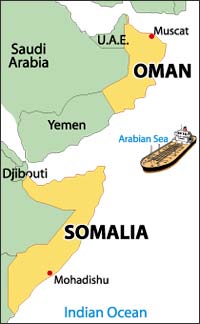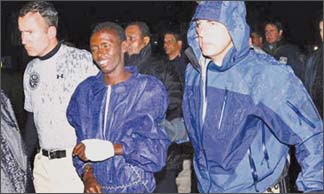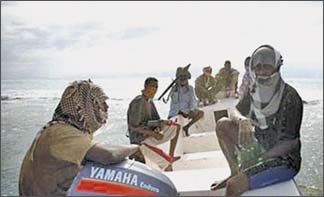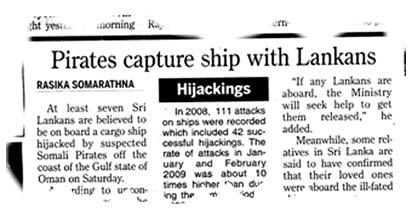Somalia land of pirates

 |
|

Somalian pirate captured by US Navy |
The history of piracy goes all the way back to ancient times, the
time of ancient Greece and Rome. Around 500 BC pirates attacked the many
cargo ships that sailed the Mediterranean Sea. Early Greek pirates used
small, fast ships that had a shallow bottom.
These ships were called triremes and had great maneuverability which
allowed the pirates to escape into bays and channels were the larger
ships could not go. A famous Roman leader was captured by pirates when
he was 25. This historic leader was none other than Julius Caesar. He
was released and then his troops caught and killed the pirates who had
captured him.
Most of the pirates who sailed the Mediterranean Sea were called
corsairs. Most corsairs were Muslims and they enjoyed plundering
Christian ships. Corsairs weren’t typical pirates. They weren’t after
treasure, they were after people. Pirates held rich people for ransom
and ordinary people were used as slaves or the pirates forced them to
work on their galleys (the ship).
The corsairs’ galley had a ram in the front and they would crash it
into their opponents. Then people called janissaries jumped onto the
other ship and captured it. Corsairs’ ships were armed with cannons and
they used scimitars (curved swords), muskets, and ornate swords and
daggers in hand to hand combat. Corsairs didn’t just attack cities and
ships in the Mediterranean, they also attacked up North. One pirate
sailed all the way to Iceland!
Piracy didn’t only occur in the Mediterranean Sea, it happened in
Northern Europe as well. Pirates up in Northern Europe were called Norse
Riders or Vikings. The Vikings traveled across the North Sea so that
they could raid British settlements. They usually carried two-edged
swords and axes. They sailed in swift longships. These ships were
flat-bottomed and could travel up river. This allowed the Vikings to
attack inland villages.This was the very beginning of piracy.
Somalian pirates
Piracy in the shipping lanes off Somalia is nothing new. The pirate
gangs didn’t suddenly decide to attack vulnerable merchant ships a few
years ago. Their evolution happned over two decades because of several
factors. First is that Somalia is one of the poorest nations in the
world, with a totally ineffective central government. In a country
without effective laws, lawlessness is not only tolerated, but often
admired.
Since the early 1990s, there have been at least 14 failed Somali
central governments in two decades. Political leaders who attempt to
ease the stranglehold the all-powerful clans have over everything
invariably end up dead or must flee the country to avoid assassination.
Piracy has become Somalia’s most important industry, with reports
that the gangs earned $150 million in 2008. And it still goes on,
virtually unchecked by any organized opposition. More than 300 ships
were attacked last year, with 20 still in pirate control, along with
more than 300 hostages, all awaiting negotiations for ransom payments.
The country is currently totally in the grip of at least four
powerful clans. Many based on family and religious extremism have been
part of the Somali scene for generations. They operate with ruthless
efficiency to control their fiefdoms, and murder and ransom have long
been weapons they use to earn power and riches.
Early 1990s
As far back as during World War II, when Somalia was a British
colony, an officer described the heavily armed clans of Somali warriors
as “ruthless outlaws who kill for the sake of killing, holding human
life cheap if it stood in the way of rape and pillage”.
According to some reports, the current use of piracy evolved in the
early 1990s from a combination of clan activity and the country’s
fishing industry. The large, highly-sophisticated, mechanized fishing
fleets from Japan, Russia and other advanced nations supposedly
constantly violated the legal waters around Somalia and began to wipe
out entire populations of fish.
Foreign ships
Their actions were killing the traditional fishing industry of the
already-poverty-stricken Somalis. In addition, as Somali pirate
spokesmen still claim today, many foreign ships used the area to dump
their highly toxic refuse, thereby speeding up the devastating process
of wiping out all marine life. Attempting to protect their territory in
the early 1990s, some Somali fishermen organized into bands of raiders,
and boarded close-in ships. Threatened with rifles, ship’s captains had
to pay the Somalis for the income loss their mass fishing operations
were causing the local fishermen.
|

Pirates attack a ship |
The reported story continues that the tributes paid by the big
fishing ships were so successful, the powerful clans in Somalia decided
to expand on the local fishermen’s idea of collecting money from the
intruders. Until recently, when the large nations began to send in armed
vessels, the pirates had a virtually free ride for more than a decade.
Because of insurance coverages and the relatively low cost of paying
ransoms, plus the fact that the pirates rarely used overt force, ship
owners cooperated. The taking of several hundred ships a year is a very
small part of the 300,000 that pass along the coast of Africa.
As long as less than one percent of ships are held for ransom,
insurance companies consider this acceptable. Of course, with the rising
tide of piracy, the premiums go up along with the ransom demands, and
shipping companies just raise prices to their customers for services.
Seizing ships became so prevalent in the early 2000s, the now
well-organized and clan-led pirates didn’t need to board some ships to
get money. All they had to do was inform shipping companies that the
pirates would allow their vessels to proceed if a tribute of several
thousand dollars, later upped to millions, were paid. Until recently,
when American and other navies became involved, even when captured, the
pirates were usually set free in exchange for ship’s crew hostages.
Weapons
With millions of dollars coming into their control almost daily, the
clans’ pirate operations continued to grow in size by recruiting willing
young Somalis, acquiring more sophisticated weapons and adding more
speedboats to their fleet. They now use so-called mother ships, large
vessels that can venture more distances out to sea and set the smaller
motorboats off on missions of piracy far beyond Somali waters.
They’ve also established sanctuary ports along the coast of Africa
where they keep captured ships and hundreds of hostages, all part of the
Somali pirates’ ongoing business of turning high profits at low risk.
Until the nations suffering the growing losses of their ships, cargoes
and crews can band together and take effective and massive military
action in the region, the Somali pirates will continue to operate with
little fear of interference.
Latest hijack with Sri Lankan crew
 In 2008, 111 attacks on ships were recorded which included 42
successful hijackings. The rate of attacks in January and February 2009
was about 10 times higher than during the same period in 2008.There have
been almost daily attacks in March with 79 attacks taking place in
which, 21 had been successful up to mid April. At least seven Sri
Lankans are believed to be on board a cargo ship hijacked by suspected
Somali Pirates off the coast of the Gulf state of Oman on June 12, 2009. In 2008, 111 attacks on ships were recorded which included 42
successful hijackings. The rate of attacks in January and February 2009
was about 10 times higher than during the same period in 2008.There have
been almost daily attacks in March with 79 attacks taking place in
which, 21 had been successful up to mid April. At least seven Sri
Lankans are believed to be on board a cargo ship hijacked by suspected
Somali Pirates off the coast of the Gulf state of Oman on June 12, 2009.
According to unconfirmed sources, the captain of the ship and several
high ranking officials on board are believed to be Sri Lankans.
A Foreign Ministry official confirming the incident, said they were
trying to get in touch with the Lankan mission in Oman and other
relevant international institutions to get a better grasp of the
situation. “If any Lankans are aboard, the Ministry will seek help to
get them released,” he added.
Meanwhile, some relatives in Sri Lanka are said to have confirmed
that their loved ones were aboard the ill-fated ship.
According to NATO, the German-owned cargo ship MV Charelle had been
hijacked 60 nautical miles south of Sur on the Omani coast,the first
recorded pirate attack in the area.
According to them, the captured ship was seeing heading southwest
towards Somalia yesterday, reportedly with none of the crew being
harmed. The latest incident came just hours after NATO Defence Ministers
decided to deploy six ships off the coast off Somalia from July to
enhance its anti-piracy operations.
More than 100 such attacks has been reported in the waters off
Somalia since the beginning of 2008.
However in all such attacks the crew and the ship has been returned
unharmed by pirates after obtaining the ransom. The Gulf of Aden is
considered as one of the world’s busiest sea lanes. However, due to the
activities of Somali pirates, the area too has become vulnerable,
specially for cargo ships in recent time.
Pirates on the prowl
* JAIKUR-I: Seized Oct. 2, 2008
The 21,040-tonne general cargo ship was detained after a dispute with
the owners over damaged cargo. Most of the 21 crew were released last
month.
* MASINDRA 7: Seized on Dec. 16, 2008
The Malaysian-owned tugboat, was seized with a barge off the Yemeni
coast. The tug has about 11 Indonesian crew.
* SERENITY
The catamaran sailing for Madagascar from the Seychelles with three
people aboard, was seized in early March.
* INDIAN OCEAN EXPLORER: Seized March 2009
The 35-metre boat was built in Hamburg as an oceanographic research
vessel. It accommodates about 12 passengers.
* HANSA STAVANGER Seized April 4, 2009
The 20,000-tonne German container vessel was captured about 400 miles
off the southern Somali port of Kismayu, between the Seychelles and
Kenya. The vessel had a German captain and three Russians, two
Ukrainians and 14 Filipinos on board.
* WIN FAR 161
Taiwanese tuna boat, seized April 6, 2009.
* SHUGAA-AL-MADHI
Seized April 9, 2009, the fishing boat had 13 crew.
* MOMTAZ 1 - Seized April 10, 2009
The Egyptian fishing vessel was detained with 18 crew.
* BUCCANEER - Seized April 11, 2009
The Italian tugboat, owned by Micoperi Marine Contractors, was
carrying 10 Italians, five Romanians and a Croatian, and was seized
towing two barges while travelling westbound through the Gulf of Aden.
* IRENE E.M. Seized April 14, 2009
The St. Vincent and the Grenadines-flagged Greek-owned bulk carrier
was hijacked as it travelled through the Gulf of Aden. Its Filipino crew
of 22 was unharmed.
* POMPEI Seized April 18, 2009
The Belgian dredging vessel and its 10 crew were hijacked about 370
miles from the Somali coast en route to the Seychelles. It had two
Belgians, four Croatians, one Dutchman and three Filipinos on board.
* ARIANA Seized May 2, 2009
The Ariana was seized north of Madagascar en route to the Middle East
from Brazil. The 24-strong Ukrainian crew were said to be unhurt. The
ship, flying a Maltese flag, belongs to All Oceans shipping in Greece. A
Ukrainian ship was hijacked on the same day in the Indian Ocean with a
cargo including U.N. vehicles. Maritime officials were unable to confirm
this seizure.
* VICTORIA Seized on May 5, 2009
The Antigua and Barbuda- flagged cargo vessel was hijacked by eight
pirates in the Gulf of Aden on its way to the port of Jeddah. The
146-metre ship had a crew of 10.
* MARATHON Seized on May 7, 2009
The 2,575-tonne boat, carrying up to 18 crew, is both owned and
registered in the Netherlands. It was carrying coke fuel.
* CHARELLE Seized on June 12, 2009
The 2,800-tonne cargo ship carrying about nine crew, was attacked 60
miles south of Sur on the Omani coast. Lloyds reported the vessel was
owned by shipping firm Tarmstedt International.
* PIRACY KEY FACTS:
— In 2008 there were 293 incidents of piracy against ships worldwide,
11 percent up on the year before. Attacks off Somalia and in the Gulf of
Aden almost trebled.
— In 2008, there were 111 incidents including 42 vessels hijacked in
the Gulf of Aden and off the coast of Somalia. So far in 2009, there
have been 29 successful hijackings from 114 attempted attacks.
— The seas off Somalia and Yemen have been the site of a total of 128
attacks so far in 2009, of which 44 resulted in successful hijacks
according to Ecoterra. — Nearly 20,000 ships pass through the Gulf of
Aden each year, heading to and from the Suez Canal.
Sources: Reuters/Ecoterra International/International Maritime Bureau
Piracy Reporting Centre/Lloyds List/Inquirer.net |



